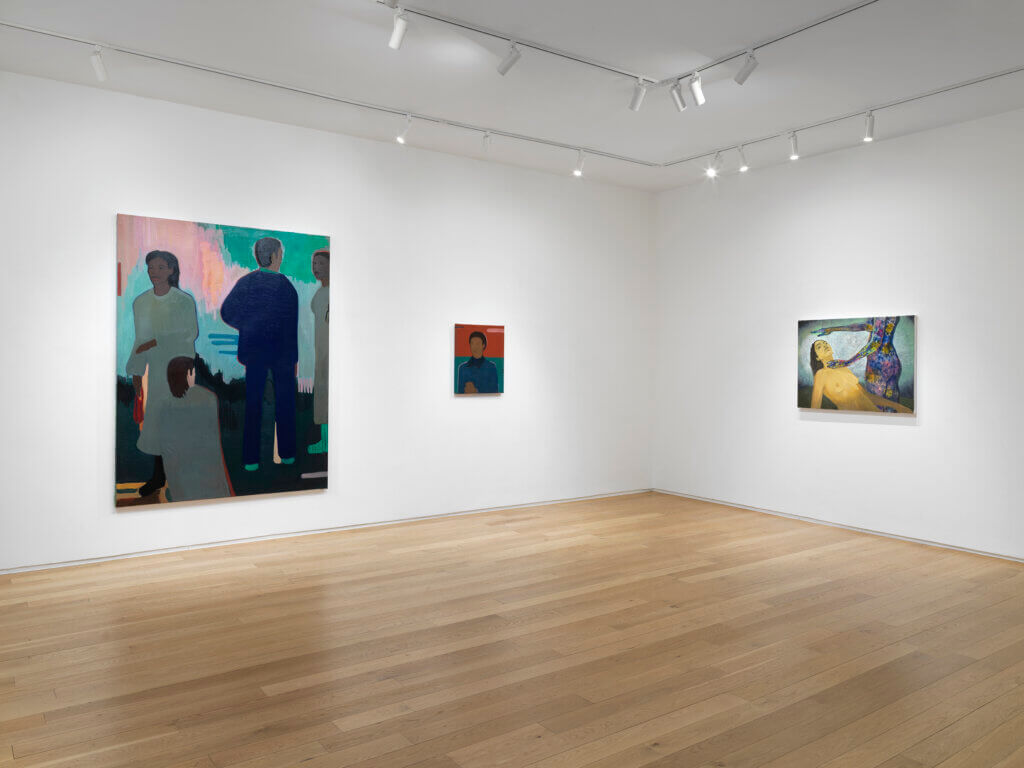
Madeleine Bialke, M. Florine Démosthène, Sahara Longe, Nadia Waheed (December 6, 2022-January 11, 2023) at Alexander Berggruen, New York.
On the occasion of our exhibition Madeleine Bialke, M. Florine Démosthène, Sahara Longe, Nadia Waheed (December 6, 2022-January 11, 2023), we spoke with Bialke, Démosthène, and Waheed about their work.
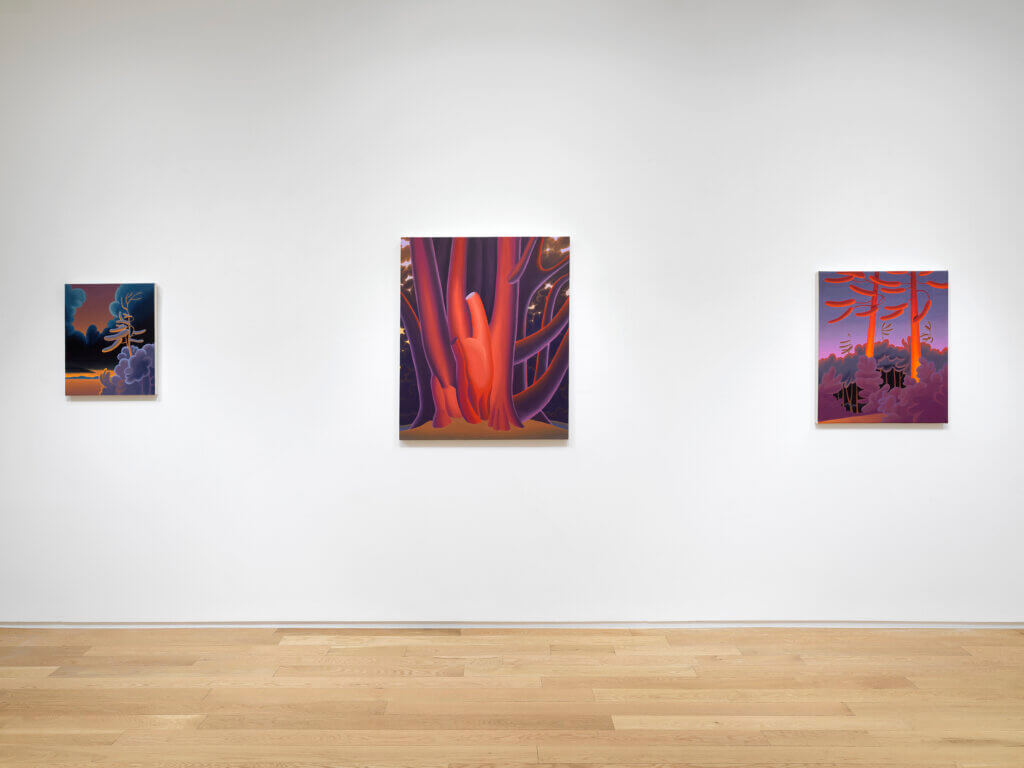
Brooklyn-based artist Madeleine Bialke paints anthropomorphized landscapes where the full-bodied trees become the principal individuals, equipped with personalities, emotions, and relationships.
Q: How do the places in which you spend time in nature influence your paintings? Do you work from image, en plein air, memory, imagination, or a combination of all of the above?
I start by making drawings from black-and-white printouts of iPhone photos taken in familiar places. I then work solely from the drawings, where visual memory plays a larger role.

Madeleine Bialke
Wisdom Teeth, 2022
oil on canvas
30 x 26 in. (76.2 x 66 cm.)
Q: The titles of your paintings seem to be deeply metaphorical. Could you share some insight into how you titled the works in this show, such as Armature, Core, and/or Wisdom Teeth?
The titles develop midway into the process of painting, usually I see some visual reference that tips me off. I wanted this series of paintings to relate trees to bodies, and in Wisdom Teeth I began to see the deep forest layer below the two trees as a mouth. Wisdom teeth, in humans, are evolutionary has-beens that serve little purpose now, and I started to see the two large white pines leaning towards each other as remnants of another age… that still have ‘wisdom’.
Q: When looking at the edges and the intersections of forms in some of your paintings, contrasting colors peak through. Could you discuss your process of layering colors? How do you determine when a color arrangement is complete and finished?
I begin with a loose color idea that builds into a more cohesive color palette over time. Core started as a green painting, which evolved into a red painting. The painting is finished when it feels like a complete thought, and the colors seem to reflect the content.
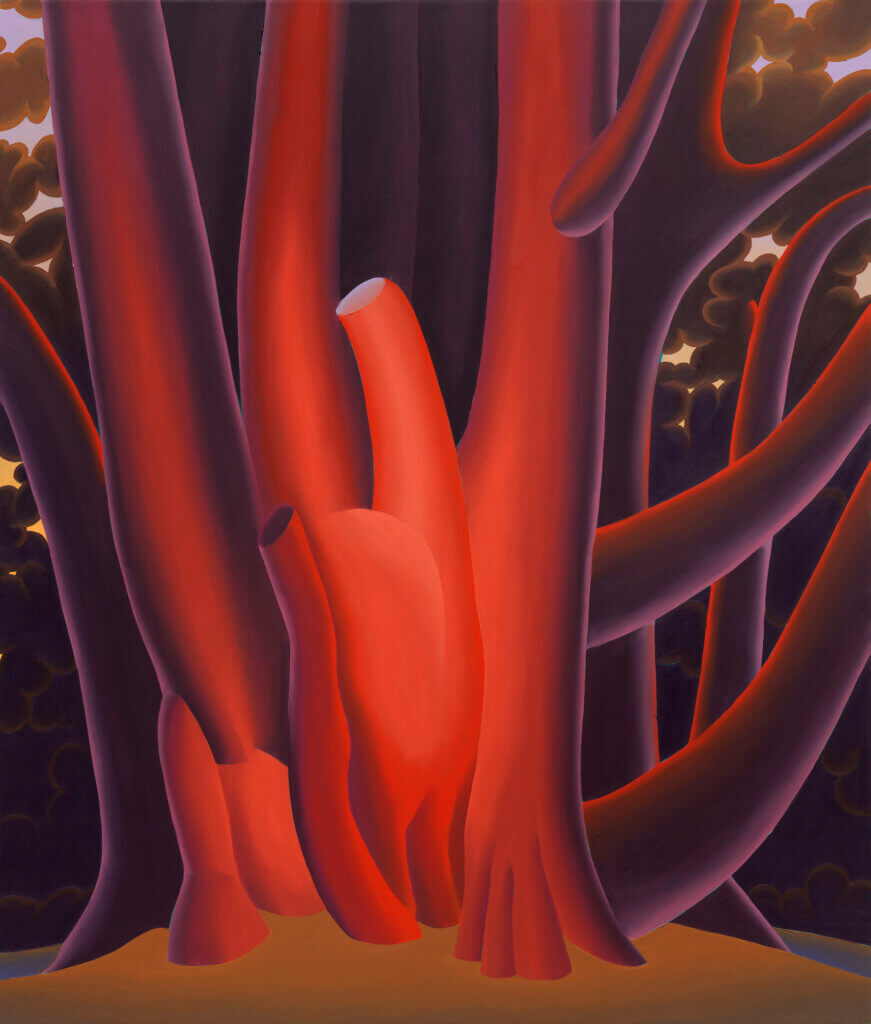
Madeleine Bialke
Core, 2022
oil on canvas
40 x 34 in. (101.6 x 86.4 cm.)
Q: Do you approach your works on paper differently than your works on canvas? How does paper function for you in your practice?
The works on paper are often preliminary studies for future paintings, but sometimes the thought is completed there. The gouache is fast-drying and easy to layer, so I use the drawings as a way to move quickly through ideas. I often make drawings at the very beginning and very end of a project, as a way to flesh out motifs.
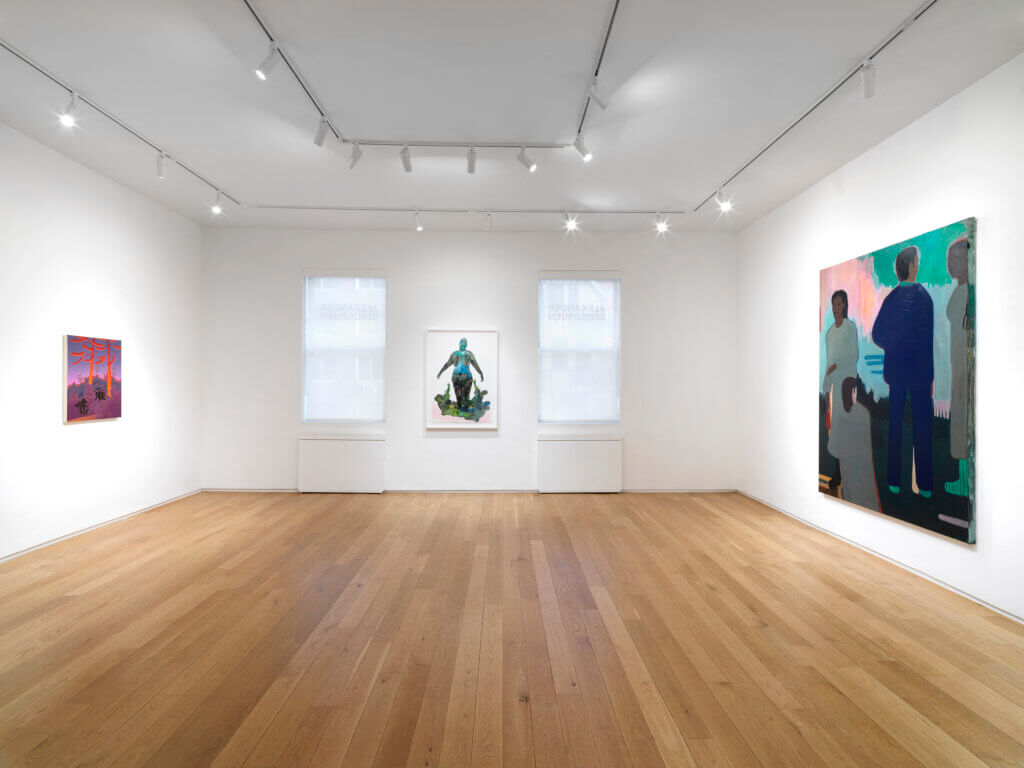
New York, NY; Accra, Ghana; and Johannesburg, SA-based artist M. Florine Démosthène constructs figures as bodies of water, embracing their shimmering, slippery, powerfully steadfast qualities. Démosthène captures an organized chaos as she composes her figures by collaging sliced components from paint spills and drips.
Q: In your 2022 painting The Ally, two figures almost mimic each other with their hips facing each other, backs arched, shoulders turned towards a viewer, and arms held out in front of themselves, overlapping slightly. Between their hands, they wield a glittery, hairlike essence of mysterious cosmic origins. Could you share some insight into the relationship between these two allies?
The titles of the work do not necessarily illustrate a specific narrative in the piece. It gives the viewer a sort of grounding in what I want to express. The dripping glitter can be interpreted as energy, spirit, emotion, etc.
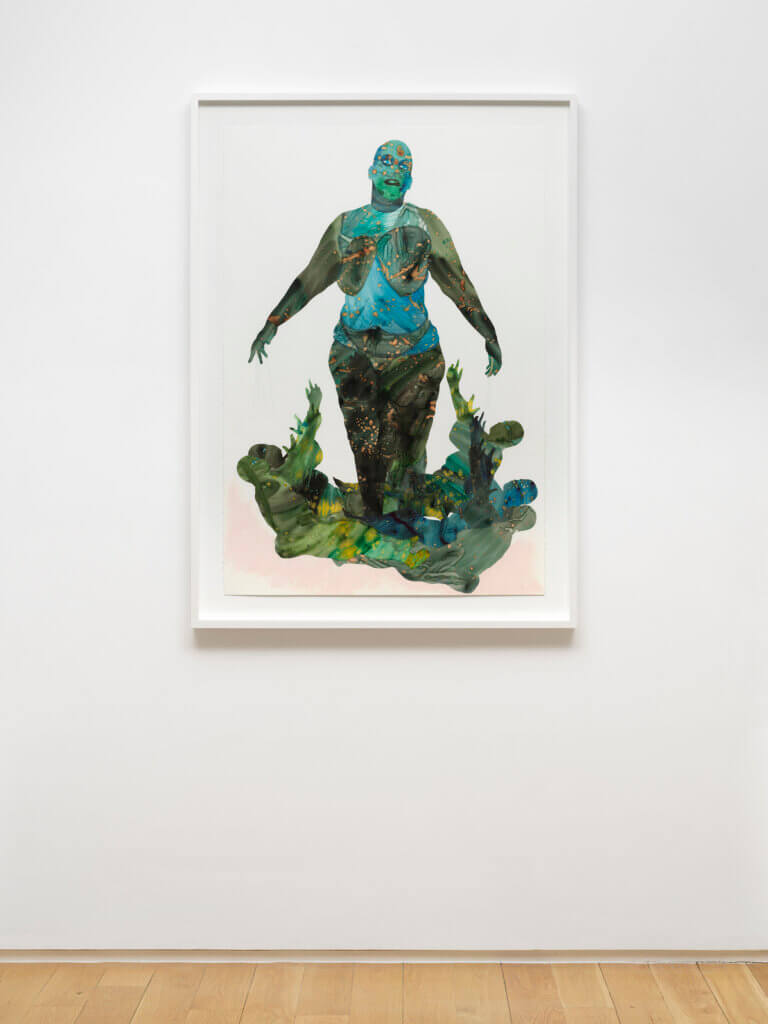
M. Florine Démosthène
Judge By Your Own Lies, 2022
collage on paper (ink, mylar, pigment stick, and glitter), framed
44 x 30 in. (111.8 x 76.2 cm.)
Q: You have kindly shared that the titles of your work come first. Could you share where the language for Judge By Your Own Lies emerged, and how it relates to the resulting collage?
That title refers to a podcast that I had listened to while creating the piece. The host was discussing how we base our existence on a foundation of lies and how we continually judge ourselves on these lies. He stressed that we spend an inordinate amount of time searching for truth, love, justice, etc., but all of these “concepts” are based upon lies that we take as truth.
Q: You have stated that your time in Ghana has influenced your approach to work, and it has been said, in particular, that your “works seem influenced by fabric dying, garment design, and production that is prevalent in Ghana”. (1) When applying ink to mylar, how do you achieve the various swirling, spotted, and loose textures?
I enjoy seeing the process of batik in Ghana, but my work is not influenced by that process. The patterning in the work is a result of the interaction of the inks on the paper.

M. Florine Démosthène
The Ally, 2022
collage on paper (ink, mylar, pigment stick, and glitter), framed
44 x 30 in. (111.8 x 76.2 cm.)
Q: The materiality of your work—ink, mylar, pigment stick, and glitter on paper—is unique. What about this media appeals to you?
The materials that I utilize allow for my process to be more direct and simple. It grants me the space to focus on the emotional content of the work.
(1) Lily Kuonen, “Declarations and Devotions,” M. Florine Démosthène, Always in All Ways (September 6-October 22, 2022), Crisp-Ellert Art Museum, St. Augustine, FL.

Austin, Texas-based artist Nadia Waheed’s paintings give form to spirituality as a fourth dimension, making clear the spectral world that exists alongside the corporeal.
Q: Often in your work, select figures are rendered in more realistic fleshy tones alongside other figures who are rendered in fantastical colors, patterns, or even mere gossamer suggestions of the contours of a transparent figure. What is the relationship between these types of figures?
My work has always been highly narrative in nature; an external processing of the happenings in my life and psychological & emotional interior. Over time, the same figures kept appearing in the compositions; in myriad relationships to each other, sometimes in harmony, sometimes in conflict. The more work I made, the more I came to realize that patterns were emerging with what each figure was doing in each painting, I began to understand more about who each figure was and what meaning my subconscious was applying to each one. I won’t pretend to know everything about who they are and have all the answers, but I do know that they are some sort of personae made material, sincere and quintessential representatives of something internal or external in my life, and in the same way that I am on a journey, they are as well.
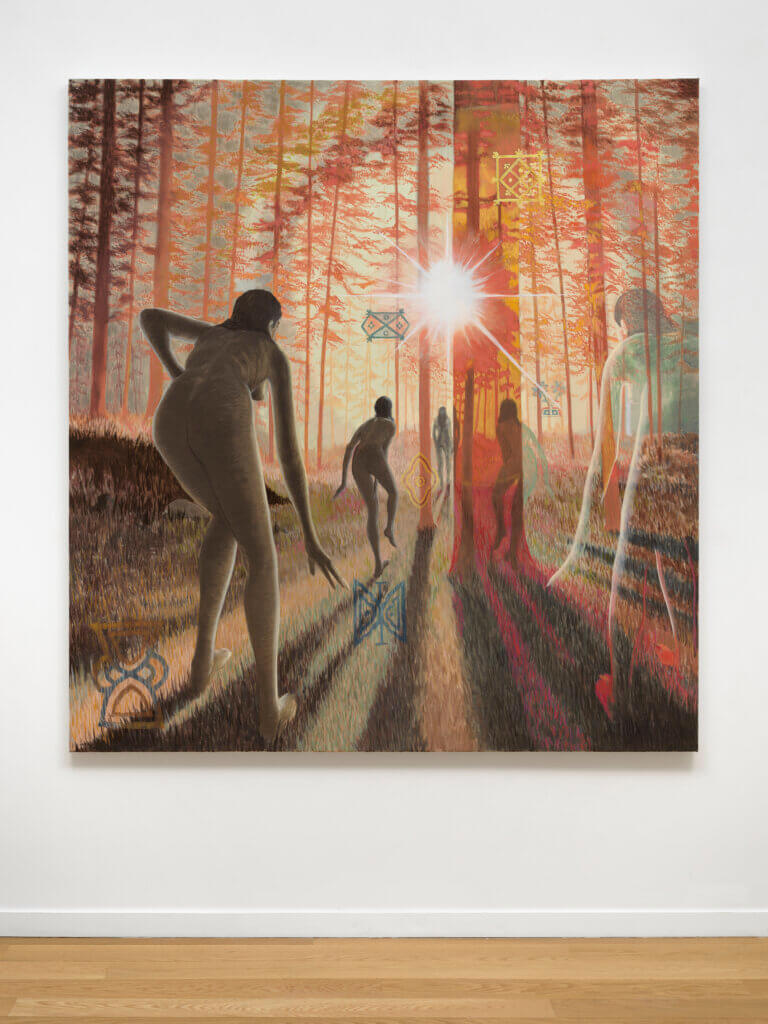
Nadia Waheed
Prophetic Medicine II, 2022
oil on canvas
68 x 64 in. (172.7 x 162.6 cm.)
Q: Your careful application of paint using thin brush strokes to produce textures and form within your paintings reveals strong draftsmanship. What role does drawing play in your practice?
The foundation of my practice is in drawing, I didn’t start painting properly until I was 24. I was always afraid of paint. The limitlessness of paint, all the things you can do with it to create dimensional space, shape, form, the edges! – I found it overwhelming (don’t even get me started on the challenges of color! Temperature, value, hue…these things I still find really challenging.)
Having always been a kid with an obsessive sketchbook habit, drawing felt simple to me. You have one line and you make things with that one line, forever and ever, page after page. When I started trying to make paintings, I was thoroughly confused. Fish out of water. I had no idea what I was doing and I decided that if I was going to fail, then fuckin aye I was going to fail fantastically and have have a lot of fun doing it. I dove in and made a huge weird mess, and I didn’t “try to paint”, rather I tried to “make a painting the way nadia would make a painting”. This reframing helped massively and some half decent works came out the other side. Hundreds of paintings later I think I’m starting to figure it out, how exactly to “make a painting”, but I still rely heavily on my drawing to carry the work.
Madeleine Bialke, M. Florine Démosthène, Sahara Longe, Nadia Waheed (December 6, 2022-January 11, 2023) at Alexander Berggruen, New York.
Artwork and Installation Photos: Dario Lasagni